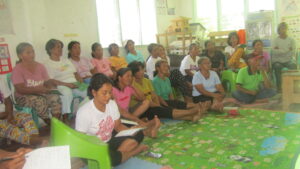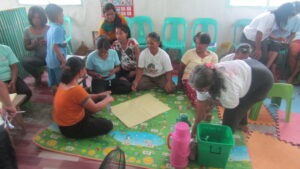LUBUAGAN, KALINGA — In a proactive move to enhance resilience against natural disasters, an indigenous community in Sitio Liglig, Tanglag, Lubuagan, Kalinga, recently completed a two-day Disaster Preparedness Training (DPT). As the world’s climate changes, disasters are becoming more common. This can be especially dangerous for small communities in rural areas. By learning how to prepare and respond to emergencies, the people in this community are working to protect themselves and their way of life.
The training covered different topics crucial for effective disaster management. Day one focused on basic concepts, including hazard identification, vulnerability, and capacity assessments, as well as sharing and validating the Community Risk Assessment (CRA) result. They discussed different types of natural hazards like typhoons, floods, and landslides. Participants engaged in interactive sessions, mapping out local risks and sharing indigenous knowledge on early warning signs. Participants shared traditional knowledge about how to predict bad weather, for example; they observed that if clouds move rapidly from east to west, a heavy rainstorm is coming, but if the movement is swift without much force, only moderate rain is expected. A concerning 100-meter crack in the upper farmlands was identified as a potential landslide risk, affecting several households during the risk mapping.

Participants actively listening and taking notes during the DPT
On the second day, participants focused on the practical side of disaster response. Community members created a worst-case scenario for a typhoon, which served as the basis for their evacuation plan. They worked on evacuation planning, with the community identifying safe places for each of the six sub-villages. Participants identified a barangay official who will lead the local Barangay Disaster Risk Reduction and Management Committee (BDRRMC),they also stressed how important these preparations are. Additionally, they temporarily identified who will act as the Disaster Preparedness Committee (DPC) within their People’s Organization. Another part of the training focused on understanding the roles and responsibilities of the Disaster Preparedness Committees (DPC) and the details of conducting Disaster Needs and Capacity Assessments (DNCA). Participants also received basic photography training, giving them the skills to document disasters accurately for better reporting and assessment.

Participants discussing with each other during the workshop on what to do before, during, after a disaster
Despite the enthusiasm, the training encountered challenges. Attendance, especially on the second day, was lower than expected. There is a recognized need for more involvement from the community to strengthen safety by increasing understanding of disaster management processes. As the training ended, both participants and facilitators remained hopeful about the community’s improved preparedness. Plans are in place for more training sessions in 2024, which will cover topics like Basic Life Support/First Aid, Bookkeeping, and Leadership.
This training serves as an example of how indigenous communities can adapt to modern challenges while respecting their traditional knowledge and practices. As climate-related disasters become more frequent and severe, these community-led initiatives may play a vital role in safeguarding vulnerable populations and preserving cultural heritage. With their newly acquired knowledge and plans, the community is becoming more resilient, showing how indigenous wisdom and modern disaster preparedness can work together to build safer, more resilient communities in the face of an unpredictable climate future.

